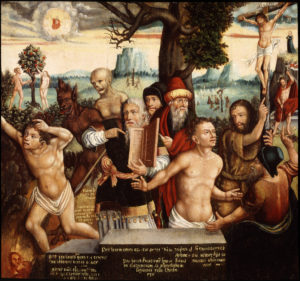Object of the Month: May 2017
Allegory on the Fall and Redemption of Man
Oil on canvas
Lucas Cranach, the Younger
German, 1515-1586
Click on links for additional reference information.
Lucas Cranach the Younger and his father (also named Lucas) were prominent painters in the town of Wittenberg. The glory of Wittenberg was its university where Martin Luther taught and its village church where the great reformer posted his 95 Theses. At this time the printing press was still in its infancy and textual literacy still the purview of scholars. There was, however, a long tradition of using iconographic painting to educate the masses—most of whom were well-versed in “reading” images. It is not surprising, therefore, that the Cranachs, who were friends of Luther, would use their skill to instruct the populace in emerging Protestant theology. This painting which unfolds Luther’s tenet of justification by faith is a good example.
The tree in the center divides Cranach’s work into a two-chapter narrative that begins with the law (left side of the canvas). The tree overhanging the characters in these scenes is dead and bare—a signification of sin. Adam and Eve’s original transgression opens the story (upper left register). The continuity of sin throughout man’s history is then presented through the Israelites’ worship of the golden calf (toward the center in the upper left register). The high point of the chapter is “played out” in a final scene in the lower left register. Here we are introduced to a hooded prophet who joins Moses in drawing our (and the sinner’s) attention to the law. Condemned by these oracles, the unfortunate Everyman is hurried into hell by grotesque personifications of Death and Satan.
Chapter two opens in the lower right register under the tree’s green bough—a signification of life and resurrection. Here we see another prophet, but this one is facing John the Baptist who points this Everyman to the crucified Christ. At the foot of the cross is the risen Savior with Death and the Devil crushed under His feet. In the distant background is the Old Testament scene of the brazen serpent, referenced by Christ in John 3:14 and 15: “As Moses lifted up the serpent in the wilderness, even so must the Son of Man be lifted up. That whosoever believeth in Him should not perish but have eternal life.” Mary Magdalene, one who has inherited this life, stands with a Lamb (symbol of Christ) on the hillside. Above her in the clouds are the Savior’s feet, signifying both His ascension and His promise to return.
Cranach also inserts into this story one of his contemporaries, Phillip Melancthon (the figure in the hat in the lower right register). Melancthon, a colleague of Luther’s and writer of the Peace of Augsburg, was an important proponent of grace in his own right. One other interesting detail is the artist’s use of text from Romans and Galatians. These Latin verses are a nod to emerging literary forms, including the translations of Scripture that were becoming more accessible through Gutenberg’s press.
To see this work and learn more about the Cranachs and their relationship to the great reformer Martin Luther visit M&G’s exhibition Luther’s Journey: Experience the History on the campus of Bob Jones University. For more information click here.
Donnalynn Hess, Director of Education
Published in 2017
